The 20 Best Sci-Fi Movies of All Time
Science fiction is a genre that enjoys enduring popularity among audiences. After all, it is in the story of the future that our modern problems are most clearly reflected, and scientific language is used to solve them rationally. What films can be considered the most outstanding sci fi items? Here is our ranking.
Science fiction movies are a film genre that very easily enters into various correlations with other conventions. Here we are dealing with characteristic means, so most often the plot is set in the future and centers around advances in science and technology. Very often it is about expeditions into space, an encounter with an extraterrestrial civilization, but also problems related to the effects of scientific experiments, such as cloning or regulation of human fertility. The attitude to this progress itself can be either enthusiastic or, on the contrary, pessimistic.
Thus, sci-fi films, depending on the subject matter dealt with, can use the formula characteristic of various film genres, such as thriller, travel, adventure, action, but also horror or even western cinema. Usually special effects and appropriate construction of scenery play a very important role. In turn, the key remains to face the relevant phenomena of modern times, the unpredictable development of which arouses fear of the unknown.
The best science-fiction movies
1. “Star Wars”
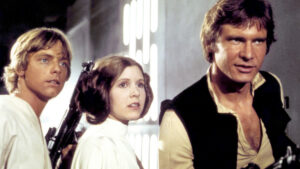
George Lucas’ “Star Wars” is a series of films that has almost become a symbol of the science fiction genre. The cycle, now nine parts long, still continues and attracts crowds of loyal fans and Jedi followers to the cinemas. Perhaps not all “episodes” of the saga are equal in artistic terms, but certainly every “Star Wars” fan is familiar with each of them.
Arranging them achronologically in terms of the date of their creation, they are “Star Wars Part I: The Phantom Menace” (1999), “Part II: Attack of the Clones (2002)”, “Part III: Revenge of the Sith (2005)”, “Part IV: A New Hope” (1977), “Part V: The Empire Strikes Back”, “Part VI: Return of the Jedi”, “Part VII: The Force Awakens” (2015), “Part VIII: The Last Jedi” (2018), “Part X: The Rise of Skywalker” (2020). The plot of each film in the “Star Wars” series is set in an unspecified distant galaxy and is based on the battle between Jedi knights and the Dark Side of the Force. Subsequent installments have featured a whole plethora of stars, such as Mark Hamill as Luke Skywalker, Harrison Ford as Han Solo and Carrie Fisher as Princess Leia Organa.
2. “2001: A Space Odyssey”, 1968
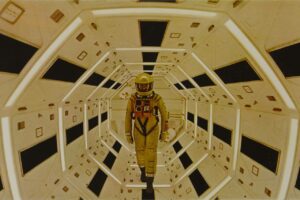
Stanley Kubrick’s 2001: A Space Odyssey is undoubtedly a work that belongs to the classics of science fiction cinema. The director portrayed the history of mankind in three episodes, set in different timelines: the prehistoric period, the era of flights to the moon and an unspecified time of interplanetary travel to Jupiter. The film starred Douglas Rain, Keir Dullea and William Sylvester.
Kubrick, showing the history of mankind since the time of the apes, raises universal questions about the origin of man, the meaning of his existence and the direction of development. Science here reveals a metaphysical perspective, and man appears as a being who, regardless of the breadth of his knowledge and achievements, cannot unravel the riddle of his individual and collective vocation.
3. “Blade Runner”, 1982
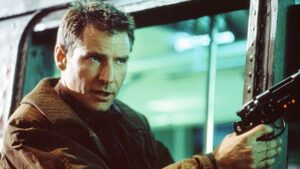
Ridley Scott’s “Blade Runner” is also a classic of sci fi films. The story of Rick Deckard (Harrison Ford), a man in charge of suppressing the rebellion of robots with human superficiality, is a tale of man’s attempt to come into contact with a machine. The android is the work of human hands, but at the same time it gains a kind of consciousness and autonomy, which makes it an autonomous entity, almost a person. How then to solve this dilemma? Can humans cope with the consequences of the invention of artificial intelligence? These are the questions posed by the film Android Hunter. It is worth remembering that Ridley Scott’s film is based on Philip K. Dick’s novel “Blade Runner”. Do androids dream of electric sheep?
4. “The Terminator”

The Terminator series of films directed by James Cameron is also an outstanding sci fi cinema entry. The first part was made in 1984, followed by “Terminator 2: Judgment Day” in 1991, “Terminator 3: Rise of the Machines” in 2003, “Terminator: Salvation” in 2009 “Terminator: Genisys” in 2015 and “Terminator: Dark Fate”. The opening film of the series starred Arnold Schwarzenegger, while Sarah Connor was played by Linda Hamilton. This work, like Androids Hunter, deals with the theme of the relationship between man and machine (in this case used for killing).
Each part of the film (except the first) repeats a symbolic scene in which the Terminator extends his hand to a man with the words: “Come with me.” One can see here a reference to Michelangelo’s famous fresco from the Sistine Chapel, in which the Creator and the creature shake hands. In turn, the figure of the terminator-man himself can be interpreted as a new version of masculinity – perfectly programmed, strong, indestructible and devoid of feelings. In this context, it seems particularly interesting that in Part III of the series the Terminator takes the form of a woman.
5. “The Matrix”
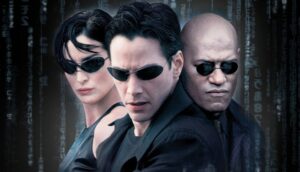
The Matrix, a series of movies at the time by the Wachowski brothers (now sisters), is a film that cannot be missing from the ranking of the best sf items. The first part was made in 1999. It starred Keanu Reeves as Neo, Laurence Fishburne as Morpheus and Carrie-Anne Moss as Trinity. The film’s plot idea is reminiscent of Stanislaw Lem’s novels (e.g., The Futurological Congress), as it involves the main character’s realization that the reality he lives in is not real, but is an illusion, the result of his mind being plugged into the Matrix. In addition to the sensational plot, the film provokes to ask age-old philosophical questions about the limits of human cognition of the world.
6. “Close Encounters of the Third Kind”, 1977
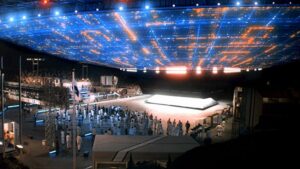
Steven Spielberg’s “Close Encounters of the Third Kind” is an sci-fi movie that tells the story of human contact with an extraterrestrial civilization, a subject that belongs, as it were, to sci fi cinema. Before their arrival on earth, the aliens make telepathic contact with the chosen ones: truck driver Roy (Richard Dreyfuss), the mother of a missing boy (Melinda Dillon) and UFO case researcher Lacombe (Francois Truffaut).
7. “Waterworld”, 1995

“Waterworld”, directed by Kevin Costner and Kevin Reynolds, is a sci-fi movie with a good storyline and acting cast. Here we witness a somewhat catastrophic scenario of the future, in which the entire Earth’s globe turns into an ocean as a result of the melting of glaciers. In these extreme conditions, man, as usual, reveals his worst face and mercilessly fights with others for the best possible living conditions. In addition to Kevin Costner, the film stars Dennis Hopper and Jeanne Tripplehorn, among others.
8. “Interstellar”, 2014
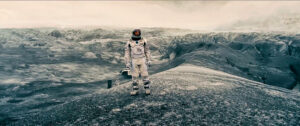
“Interstellar” – an sci-fi movie by Christopher Nolan – is, like all works of this filmmaker, a picture unique and planned in every detail. The plot revolves around the search in space for a new place for humanity due to the deteriorating climate on Earth. Thus, a carefully selected group of daredevils embarks on an interstellar journey to save the inhabitants of the third planet from the sun. Starring Matthew McConaughey and Jessica Chastain in the lead roles. Interstellar uses a lot of interesting theories in physics and philosophy, provoking basic questions – where did we come from and where are we going?
9. “Gattaca”, 1997
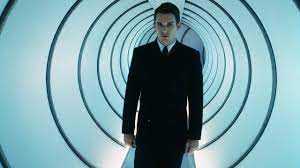
“Gattaca” by Andrew Niccol is an sci-fi film that presents an anti-utopian vision of a future society, arranged on eugenic principles. Indeed, an individual’s social standing is determined by a particular set of genes – people conceived not by natural means, but as a result of planned mutation of DNA materials are promoted. However, the main character Vincent Freeman (Ethan Hawke) is able to cheat the system and get into the elite group despite the fact that he was simply born out of his parents’ love. Gattaca is a movie that interestingly problematizes issues related to modern procreation, such as the separation of sex from reproduction and in vitro fertilization.
10. “Avatar”, 2009
![]()
James Cameron’s “Avatar” is a sci-fi movie that could not be missing from our ranking if only for its breakthrough in cinema technology – the first picture made in 3D. A paralyzed commando Jake (Sam Worthington) is introduced into the life of the planet Pandora inhabited by a community slightly different from humans. Thanks to complex technology, the man takes the form of an Avatar and manages to gain the trust of the inhabitants of Pandora. However, the fate of the planet is threatened. Cameron’s Avatar is one of the stories of an alternate world, which virtual reality can often become.
In 2023, the sequel to James Cameron’s huge blockbuster, titled “Avatar: The Being of Water,” entered theaters. It is a spectacular work that captivates with magnificent shots of aquatic landscapes and proves that going to the cinema in the age of VOD platforms still makes sense. The viewer, during the long screening, can relax and almost tangibly feel like a mesmerizing inhabitant of the alternative world created by the creators.
11. “Metropolis”, 1927
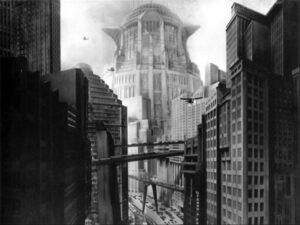
This is one of Fritz Lang’s cult films, which has gone down in cinema history not so much for what it tells about, but how it does it. From the very beginning, the production had the goal of overshadowing Hollywood with scenic grandeur. And it has indeed succeeded. “Metropolis” is a vision of the society of the future, in which there has been an extreme division between the ruling class, settled in the magnificent edifices of the giant city, and the slave working class. Representatives of the latter live in a grim underground metropolis. The son of the ruling tyrant, Freder, falls in love with the beautiful Maria of the people. Meanwhile, his father is about to unleash a revolution with the help of a demonic robot, which he gives the superficiality of Freder’s beloved.
“Metropolis” is a visual masterpiece, still captivating today with its depiction of the futuristic city and its twofold face: the giant moloch on the surface and the expressionistic landscape of the underworld. There is a masterful handling of light, giving the whole thing an almost musical rhythm. Mass scenes, in which the crowd resembles moving geometric solids, reflecting social mechanicism, have gone down in history. It is worth mentioning that in 1984 Giorgio Moroder made an abridged reconstruction of the original with rock music uploaded, which aroused great public interest and contributed to the renaissance of old cinema.
12. “The Day the Earth Stood Still”, 1951

Robert Wise’s movie is one of the classics of science fiction cinema, and its message is a warning against the negative consequences of the progress of science and technology. It should be remembered that the picture was created in a specific political context: during the Cold War. One day an inhabitant of an alien planet named Klaatu (Michael Reenie) and his robot arrive on Earth. As it soon turns out, the alien has a very important mission to carry out, which can save the future of our globe. But will humans listen to Klaatu’s advice?
Robert Wise’s picture was nominated for a Golden Globe, and was also awarded three times by the American Film Institute. “The Day the Earth Stood Still” was appreciated as a representative of classic film genres, an inspiring movie of all time, as well as an American thriller. The film’s magnificent music was composed by Bernard Herrmann.
13. “Alien”, 1979
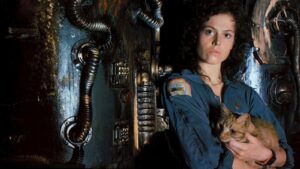
Ridley Scott’s cult movie is a combination of science fiction and horror cinema. The spaceship Nostromo, while on an interstellar journey, receives a mysterious distress call – S.O.. S. The crew awakened from hibernation decides to land on the planetoid and investigate the situation. On the spot, an unidentified creature is thrown at one of the crew members, Kane….
Awarded an Oscar for best special effects, “Alien” launched a whole series of films. The work, along with “Blade Runner”, belongs to the so-called “dark future” trend, in which the most important issue becomes the pessimistic future of humanity and the moral problems arising from the increasingly close relationship of humanity with technology. A great creation of a strong, courageous heroine in the following parts was created by Sigourney Weaver.
14. “The Hunger Games”, 2012
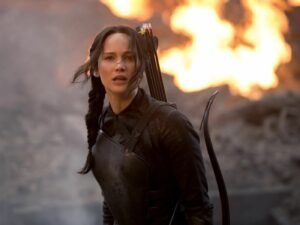
“The Hunger Games”, directed by Gary Ross, opens the acclaimed film adaptation of Suzanne Collins’ trilogy. The movie is set in the totalitarian state of Panem, where the dreaded Hunger Games are held every year. They involve a fight to the death between young representatives of the 12 Districts. The winner of the bloody tournament becomes part of the wealthy world of the elite. When Kathleen is selected in the draw for the participants of the Twelfth District, her older sister Katniss decides to replace the girl. The lead role was wonderfully performed by Jennifer Lawrence.
The movie is a vision of a grim anti-utopia – a futuristic world with cruel and humane laws devoid of human dimension. The majority of society lives in derogatory conditions and suffers hunger, while the privileged elite wallow in luxury. All culture and art are annihilated, and their place is taken by aggressive pop culture, the quintessential form of which is bloodthirsty TV shows that feed on the most primitive instincts. Mass entertainment is designed to cover the true face of totalitarian power.
15. “Twelve Monkeys”, 1995
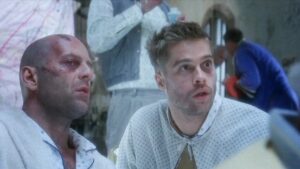
Terry Gillian’s sci-fi film is a Golden Globe-winning (for Best Supporting Actor for Brad Pitt) story about a prisoner who is given a very unusual but momentous mission to carry out. Namely, James Cole (played by Bruce Willis) is sent to the past to prevent the outbreak of a pandemic. By mistake, instead of 1996, he ends up in a space-time six years earlier. He is quickly judged as an antisocial and insane individual, and ends up in a mental hospital, where he meets the son of a famous scientist. Six years from now, it is Jefrey (Brad Pitt) who will head the Army of 12 Monkeys, which will spread the virus.
“Twelve Monkeys” brings a striking picture of a post-apocalyptic world nearly depopulated by an unknown plague. The few survivors have to exist in terrible conditions underground, as the deadly particles of the deadly virus are still on the surface. The idea was born out of inspiration from Chris Marker’s short film “Short” and remains remarkably fresh today, especially in the context of the Covid 19 pandemic.
16. “Mad Max: Fury Road”, 2015
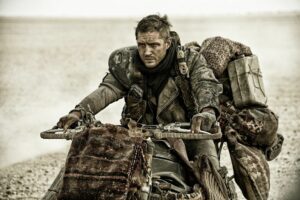
George Miller’s movie “Mad Max” won as many as six Oscar statuettes in important categories for science-fiction cinema. The picture was recognized, for example, for characterization, production design and costumes. The world is destroyed by a nuclear war. The surface of the Earth becomes a rocky and sandy desert, which lacks water and basic living conditions. From the settlement ruled by a crazed tyrant escapes Imperator Furiosa, who kidnaps with her the entire harem of the ruler’s wives. The fugitives are joined by Mad Max, who roams the wilderness alone.
The lead roles were played by Tom Hardy and Charlize Theron. The actress definitely dominates the film with her incredible performance and charisma. The sheer superficiality of the phenomenal Charlize in the role of a one-armed avenger with a bald head magnetizes the viewer. In addition, the female plot clearly gives the whole thing a feminist touch and is a premonition of the next stage of women’s emancipation looming on the horizon of history.
17. “The Martian”, 2015

2015’s “The Martian” is another work that proves Ridley Scott’s genius as a science-fiction filmmaker. The picture is based on the novel by Andy Weir. A research expedition on Mars must evacuate quickly due to a sandstorm. One of the crew members stunned during the turmoil fails to make it to the ship and when he regains consciousness after some time, he realizes that he was left all alone with meager supplies. However, he manages to make contact with the crew. The man hopes to survive and return to Earth….
The leading role in the film was played by Matt Damon, who created an interesting portrait of Robinson Cruzoe of the future. The man’s knowledge and ingenuity help him arrange life on the Red Planet. However, the key to survival turns out to be hope and faith that, contrary to scientific calculations, the impossible can happen. Thus, man takes his human qualities and values even to an alien planet.
18. “Gravity”, 2013

Alfonso Cuaron, in his acclaimed movie of recent years, presented an interesting science fiction story about two astronauts exploring the mysteries of space. When a disaster occurs on the station, Ryan (Sandra Bullock) and Matt (George Clooney) try to find a method to safely return to Earth. However, the situation becomes increasingly complicated.
“Gravity” was awarded seven Academy Awards, including Best Special Effects. In addition to gripping action, the film also has a deeper message. Staying in space allows the characters to gain a unique perspective of distance – to their own planet and the problems left on it. At the same time, the title gravity acquires metaphorical meanings – for it becomes a natural energy that, despite the most difficult experiences, still attracts man towards Earth.
19. “The Fifth Element”, 1997

Luc Besson in “The Fifth Element” presented a futuristic vision of New York. The story is set in the American metropolis in 2263. It is a time when the Earth is threatened by a deadly danger from an absolute Evil that gains power once every 5,000 years. The inhabitants of our planet have their defenders – the Mondoshawans – a people from another galaxy.
Unfortunately, their spaceship is shot down, but scientists from the organic remains found manage to reconstruct a person from the crew, a certain Leeloo (Milla Jovovich). The girl escapes from the lab and jumps straight into the cab of a former commando, Korben Dallas (Bruce Willis). Soon together they set out to find the “fifth piece” of the puzzle that can save the world from annihilation. Luc Besson’s film was awarded a BAFTA statuette for special effects.
20. “Contact”, 1997
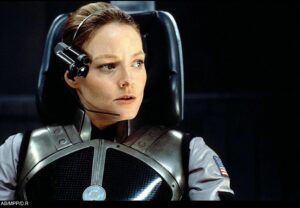
Robert Zemeckis’ “Contact” is a very interesting sci-fi film about the encounter between man and an extraterrestrial civilization. The picture was based on a novel by Carl Sagan. The leading role is played by Judy Foster, who plays Ellie Arroway, who investigates the existence of intelligent life forms in space. One day the woman receives a mysterious signal from the star Vega. It turns out that it transmits instructions for the construction of a one-man ship used for intergalactic travel. Ellie wants to fly on this dangerous mission.
Zemeckis’ movie is primarily a story about the clash of radically different visions of the world and man. After all, the main character is an agnostic, but the experience she will face will seriously disturb the protagonist’s previous views. It will force her to ask herself anew questions about destiny, God or posthumous existence.
